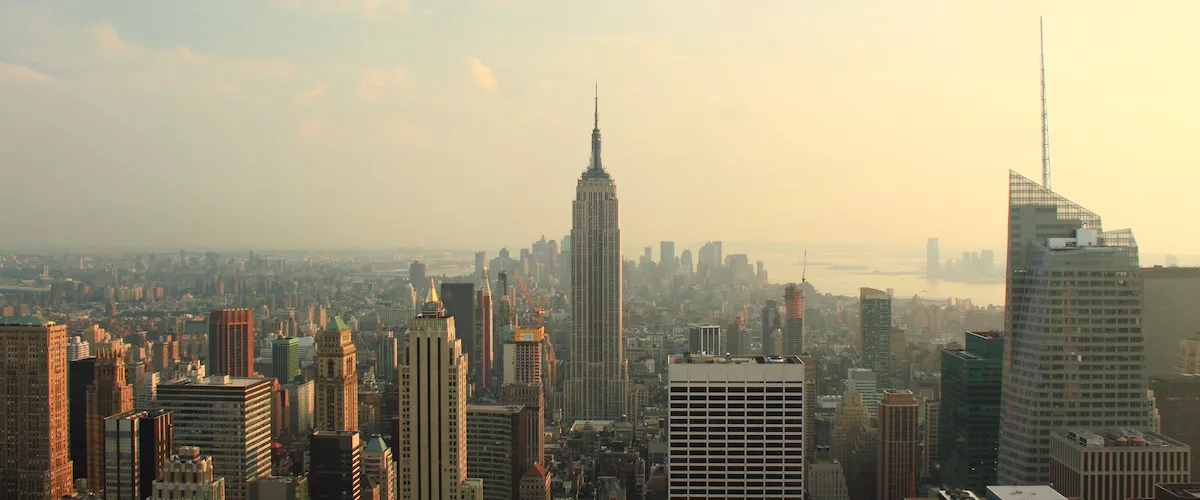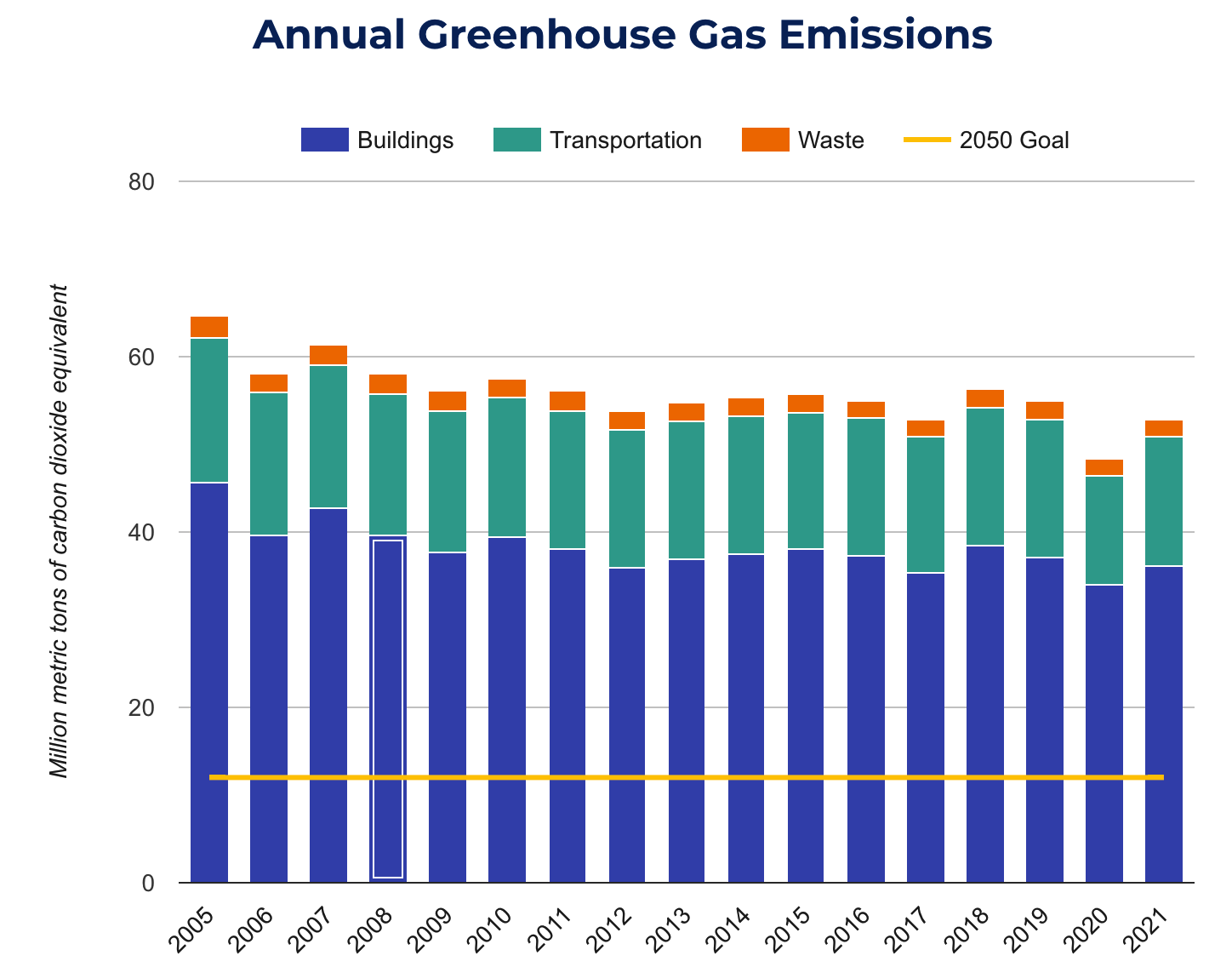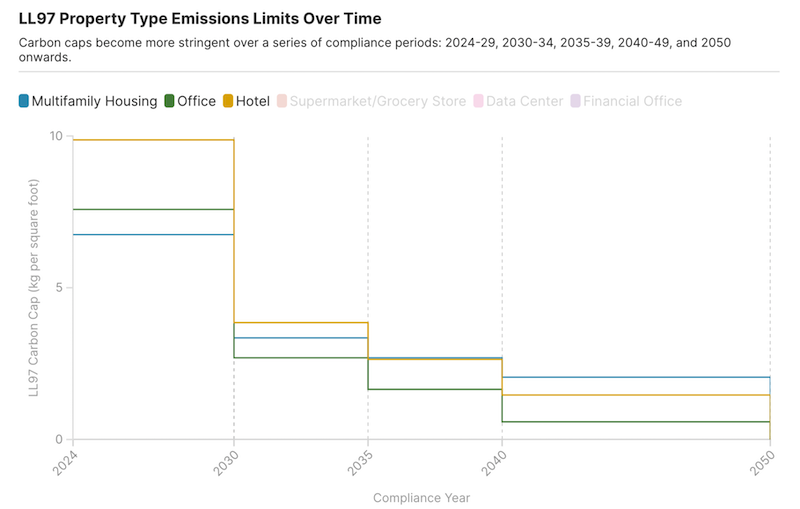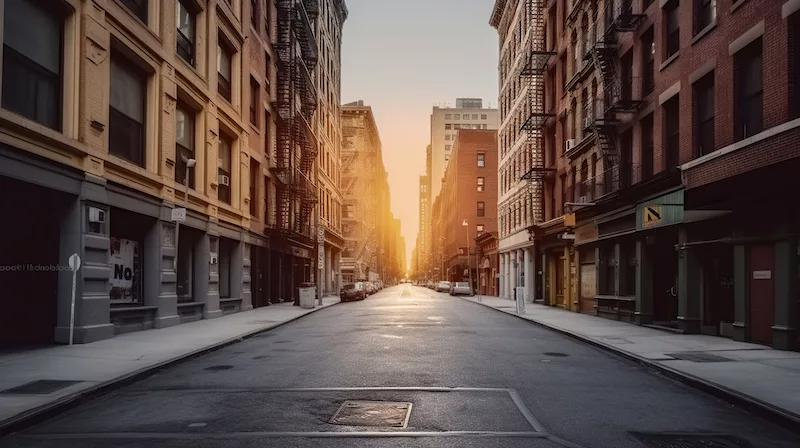
On October 24, 2023, the New York City Department of Buildings (DOB) held a virtual, public hearing to discuss proposed amendments to the non-compliance rules associated with Local Law 97. There’s a growing debate about the impacts of these ‘good faith efforts,’ which we’ll cover more below. But first, a quick recap.
What is LL97?
In 2019, the New York City Council passed Local Law 97 (LL97) as part of the Climate Mobilization Act, then-Mayor de Blasio’s ‘Green New Deal.’ The law is focused on cutting the greenhouse gasses produced by buildings in New York City. Data from the NYC Greenhouse Gas Inventory show that building emissions accounted for two thirds of the annual greenhouse gas emissions in 2021.

LL97 aims to lower emissions by setting carbon caps for buildings over 25,000 square feet—roughly 50,000 buildings that contribute 50% of NYC building emissions. The carbon caps start in 2024 and become incrementally more limiting through the year 2050.
The law imposes financial penalties for buildings and property managers who do not meet the proposed emissions standards. To account for the costs of improving building emissions, the law includes provisions for low-interest loans and also allows some affordable housing to opt for low-cost, energy-saving measures instead of emissions limits.
For more info, here’s a summary from Urban Green Council.

Good Faith Efforts
Since its passage, the Office of Building Energy and Emissions Performance (OBEEP) was created to oversee implementation and compliance. Significant time, resources, and funds have been invested in the success of this project. Naturally, the law has also seen a fair amount of critique, including a lawsuit filed by a group of building owners.
In preparation for the first round of implementation in 2024, Mayor Adams launched the “Getting 97 Done” plan—which outlines four tactics for achieving decarbonization goals:
- Identifying and targeting city, state, federal, and utility-based financing and funding for upgrades
- Providing buildings with needed technical advice through the NYC Accelerator
- Implementing key enforcement mechanisms via a Department of Buildings (DOB) rule package
- Decarbonizing central systems in partnership with New York State
The DOB rule package mentioned above defines the requirements for meeting ‘good faith efforts’ in the 2024-2029 compliance period—a designation that precludes building owners from receiving fines related to non-compliance with the emission stands outlined in LL97. According to a 2022 city analysis, this could impact 11% of buildings that are currently exceeding emissions limits.
Debating the True Cost of Climate Action and Inaction
This catches us back up to Tuesday, October 24. Following a 30-day comment period, the DOB convened, offering an opportunity to comment on proposed rules.
Reading through the comments on the public forum, the sentiment was largely that of frustrated climate activists. Two particular areas of discontent include a two-year extension for buildings not yet in compliance for 2024, and the option of purchasing renewable energy credits, or RECs, which can offset excess emissions, starting in 2026.
Many, like Rev. Jeffry Courter, feel that the proposed delays will contribute more inequity in air quality amongst marginalized communities. “Climate change has had its severest impact on the poor and marginalized of our society,” said Jeffry. “I know that LL97 was written to address mitigating the effects of our warming planet, and that this makes it a moral issue…Putting off aggressive enforcement of LL97 is the wrong direction, not only for our city, but for humanity.”
This urgency for action was reflected in many of the public statements, as shown in this contribution by Heather Foster:
“The city needs to do more, not less, in the face of the Realestate lobby and landlords. We all must do more as this climate crisis is here, now. It’s imperative that the city not weaken enforcement of Local Law 97.”
Of course, not everyone offered that same viewpoint. Fiona Cousins, Principal in the New York office at Arup and self-described member of the LL97 advisory board wrote:
“The new rules also provide some new pathways to ease enforcement: the purpose of the law is to reduce carbon emissions, not to collect fines, so these seem to me to be consistent with the overall purpose.”
The DOB’s plan cites concerns that the pandemic and associated repair costs may limit building owners’ ability to comply with LL97 standards. This sentiment was reflected in a number of comments representing co-op and condo spaces—like this one from Pete Klosterman:
“I support DOB’s proposed rules because it is a major step toward full implementation of the law. It effectively strikes a balance between addressing challenges faced by buildings such as co-ops and condos and the urgency to reduce climate-warming emissions and achieve the long-term goals of Local Law 97. With the introduction of a new credit for early electrification work, it will encourage the installation of energy-efficient electric heating, cooling, and hot water systems before 2030.”
However, several entries associated with the group WEACT For Environmental Justice shared a statement refocusing the issue on tenants’ rights. It read, “I urge the City to strengthen tenant and anti-displacement protections in the rules, to prevent the possible gentrification and displacement of New Yorkers from their homes, especially vulnerable New Yorkers who have done the least to cause the climate crisis and are exposed to the negative consequences the most.”
Others, like Courtney DeLong expressed concerns about the lack of enforcement plan for the ‘good faith efforts.’ She also echoed concerts about affordable, reliable housing. Courntey added that “there should be compliance exemptions for buildings and affordable housing residents who need it, not for buildings simply trying to delay implementation.“

What’s Next for LL97 and Building Decarbonization?
Following the hearing, the DOB is reviewing the written and verbal statements and plans to finalize the rules by the end of the year.
This law in New York City represents just one of many building decarbonization efforts in the US. In fact, a study by the Building Decarbonization Coalition found that one in every five Americans lives in an area that has passed a building decarbonization policy. That said, LL97 does have the distinct opportunity to serve as a blueprint for larger municipalities looking to equitably decarbonize buildings and reduce greenhouse gas emissions.
Carbon Reform is built on the belief that carbon dioxide is a localized and community problem. Our aim is to address air quality through the lens of equity and human health by democratizing access to carbon capture technology for all, including underserved communities who are eligible for Good Faith Effort rules.
We’ll accomplish this mission using the existing infrastructure in our schools, offices and homes—the places we spend the majority of their time. Our solutions easily integrate into existing building ventilation systems, helping building owners save energy, improve indoor air quality for occupants, and directly sequester tons of CO2 annually. See how our technology works, and find ways to get involved with Carbon Reform today.
